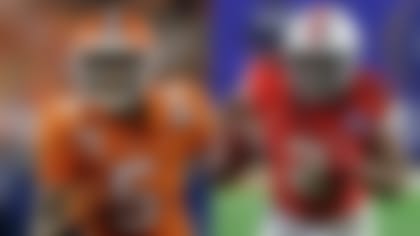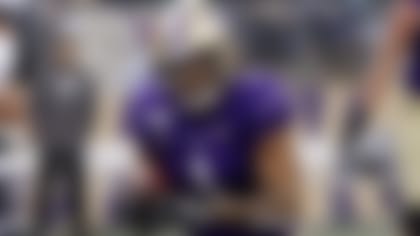With the 2020 NFL Draft just around the corner, I've put my context-based data models to work in search of identifying the best team fit for some of the top players in this year's class. Leading up to Round 1, I'll be taking my top five highest-rated wide receivers, running backs and quarterbacks and pairing them with the team with whom the *player earns the highest win share in 2020, given what we know about each team's personnel, coaches and strategy right now.*
Note: None of these pairings are projected to occur in Round 1.
1) D'Andre Swift + Tampa Bay Buccaneers = +0.51 wins
In 2019, the Bucs averaged 3.7 yards per rush (28th in the NFL) and managed just 39 rushes of 10 or more yards (tied for 24th). They also only used play action on 16.8 percent of dropbacks, per Next Gen Stats, which ranked 30th. Oh, and I presume you've heard about their new quarterback. OK, now that we've got that level-setting out of the way, let's get to the good stuff. Swift is such an exceptionally strong fit with the Bucs, thanks to the style of offense he was asked to execute at Georgia and his ability to be extremely productive in it. These two factors forecast for a shorter learning curve in the NFL. No back in this class helped his team stay ahead of the chains when contacted on rushing downs more than Swift (7 percent more than the next-closest RB, per my Computer Vision tracking). And considering the number of inside rushes we saw from him last year, that stat is particularly impressive. The 21-year-old is also a skilled route runner (ranked second-best in my CV-tracked route running model) and has great hands (just three drops on 76 targets, per Pro Football Focus) -- and we know how much No. 12 loves to target his RBs.
2) Clyde Edwards-Helaire + Detroit Lions = +0.44 wins
Clyde Edwards-Helaire's use in the passing game is what distinguishes him as the second-best back in the class, per my model, and it's what drives his fit-value when paired with the Lions. The LSU product is my model's highest-rated pass-catching back, as measured by route diversity, precision and yards after the catch adjusted for route type (in 2019). On the ground, Edwards-Helaire's ability to avoid run-stopping contact (as measured by positive yards earned after hip direction changed when a defender was within 3 feet) ranked second-best in 2019 among RBs in this class. Lions running backs were not a source or threat of big plays last season, producing just 39 rushes (tied 24th) and 15 receptions (30th) of 10 or more yards, and averaging just 6.6 yards per reception (30th). Adding Edwards-Helaire would allow the Lions' offense to be more multiple and would drive overall efficiency.
3) Zack Moss + Atlanta Falcons = +0.41 wins
Atlanta took a flier on former MVP candidate Todd Gurley this offseason, signing him to a one-year deal worth up to $6 million. I like the move for the Falcons, but I like it even more when I think about Gurley potentially pairing with Moss to form a backfield that would help drive team wins. To say Atlanta's run game struggled last year would be an understatement. The 30th-ranked run offense (80.1 yards per game) could barely get anything going inside last year, producing just eight rushes of 10 or more yards between the tackles (fewest in the NFL), while facing stacked boxes 29.6 percent of the time (third-highest rate). Moss' resume at Utah suggests he'll be able to boost those numbers significantly: He avoided run-stopping contact in 2019 at the highest rate among RBs in this draft class. By adding his ability to break tackles to a resurgent Gurley, the Falcons project as a top-10 group in yards per rush in 2020 -- a night-and-day difference from where they finished last season (ranked 26th at 3.8 yards per attempt).
4) Jonathan Taylor + Philadelphia Eagles = +0.40 wins
My favorite model observation from Taylor's college resume is his consistent speed after contact. The way I measure this is by tracking how fast a player is traveling prior to contact, and then how fast he's going after contact. While not all contact is created equally, and I can't measure the force of these shots, I can tell you that if a running back (in power five schools) took a hit, but wasn't stopped, his speed was reduced an average of 54-68 percent (within a 5-yard gain of the line of scrimmage, range reflects different schemes and where they were rushing) last season for their next 3 yards. Not Taylor. His speed dropped just 42-49 percent. Paired with Miles Sanders, this combination forecasts to help drive down the Eagles' 31 fumbles (tied for most) from last season.
5) J.K. Dobbins + Kansas City Chiefs = +0.40 wins
Last season, the Chiefs used play action on 28.8 percent of dropbacks (fifth-highest in the NFL, per NGS). Why am I leading with this? Because one of the most interesting notes from Dobbins' tenure at Ohio State was the fact that he caught at least 22 passes in each of his three seasons. And here's the special part: He was spectacular in pass protection, especially against linebackers. The Chiefs also only had 33 rushes of 10 or more yards last season (29th in the NFL), and Dobbins' game speed measured second-fastest in this RB class. With Andy Reid crafting plays for Dobbins, his transition to the NFL projects to be mutually beneficial with big-play upside.
Follow Cynthia Frelund on Twitter @cfrelund.












